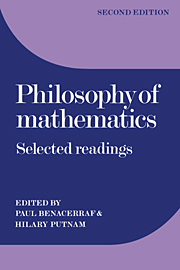Introduction
Published online by Cambridge University Press: 05 June 2012
Summary
General remarks
It would be difficult to say just what comprises the philosophy of mathematics – what questions, views, and general areas should be covered in a book such as this. With that as our excuse, we have not tried to bring together a collection of selections that could be said to cover the field in a comprehensive way. We have tried rather to bring together selections that we felt were interesting in their own right, and that offered interesting comparisons when read together, all with the proviso that the issues discussed in them were in most cases central to the field. If we have succeeded, then we are certain that the reader has an adequate introduction to the philosophy of mathematics.
The divisions we have chosen are largely arbitrary, as the following remarks will indicate, and no importance should be attached to a particular article's being in this section rather than that. With this much said, we can state that the motivation behind the sections is roughly as follows: We included in Part I those selections that centered around three traditionally important views on the nature of mathematics: logicism, intuitionism, and formalism. This is not to say that other articles in the book do not bear on these views. For example, the article by Hempel in Part III is itself a very clear exposition of logicism. Like the other pieces in Part III, however, it discusses the view on a (mathematically) less technical plane and is therefore more readily accessible to people with no formal training in logic than the papers in Part I.
- Type
- Chapter
- Information
- Philosophy of MathematicsSelected Readings, pp. 1 - 38Publisher: Cambridge University PressPrint publication year: 1984

